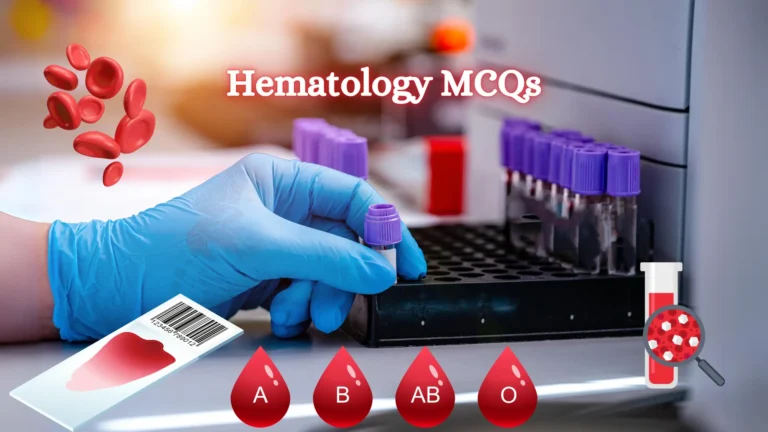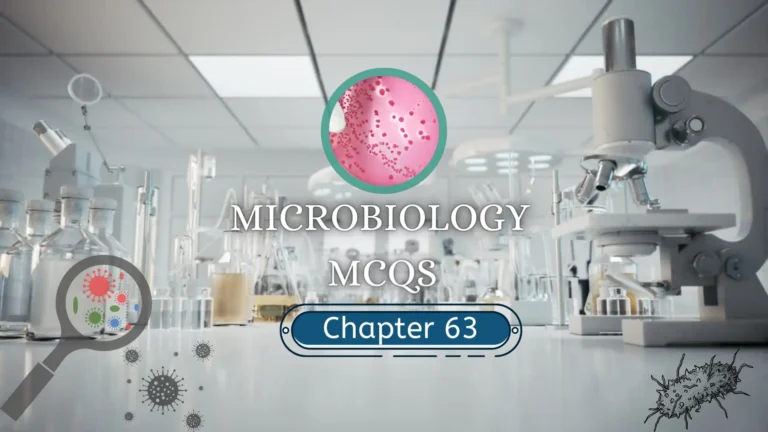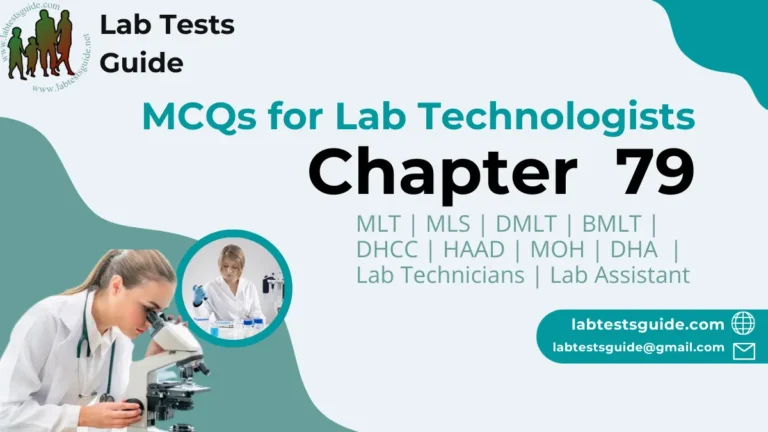5000 Plus MCQs for Lab Technician and Technologists are designed to test the knowledge and proficiency of laboratory professionals who work in the field of clinical laboratory science. These questions cover a wide range of topics related to laboratory science, including anatomy, physiology, microbiology, chemistry, and hematology.

1901 to 1950 MCQs for Lab Technician and Technologist Exam Preparation
If You like then share this to your friends and other social media.
If You have any question and suggestions then please Contact us Here
Questions 1901 to 1950
- An immunoglobulin is a
- glycoprotein ✔
- fatty acid
- protein
- carbohydrate
- An antigen that overstimualtes the immune system by binding nonspecifically to MHC on antigen presenting cells is termed
- Non specific antigen
- Toxic shock syndrome
- Super necrotic
- Super antigen ✔
- Epitope
- Individuals of blood group type AB:
- Are Rh(D)-negative
- Have circulating anti-A and anti-B antibodies
- Are “universal recipients” of transfusions ✔
- Have the same haplotype
- The membrane IgM and IgD on the surface of an individual B cell:
- Are identical except for their CH regions ✔
- Have identical heavy chains but different light chains
- Are identical except for their VH regions
- Have different VH and VL regions
- Which of the following antibodies would most likely be found in body secretions such as tears, milk, saliva and mucus?
- IgG
- IgE
- IgM
- IgA ✔
- IgD
- Which one of the following is NOT true of the gene segments that combine to make up a heavy chain gene?
- A V segment and a J segment are preselected by an antigen to make up the
- variable-region portion of the gene. ✔
- Many V region segments are available.
- Several J segments and several D segments are available.
- V, D, and J segments combine to encode the antigen-binding site.
- Mitochondria are missing in
- Filamentous fungi
- Cestodes
- Protozoan parasites
- Yeasts
- Bacteria ✔
- Which one of the following statements is the MOST accurate comparison of human, bacterial, and fungal cells?
- Human and bacterial cells have plasmids, whereas fungal cells do not
- Human and fungal cells have a similar cell wall, in contrast to bacteria,
- whose cell wall contain peptidoglycan
- Human and fungal cells have similar robosomes, whereas bacterial ribosomes are different ✔
- Human cell undergo mitosis, whereas neither bacteria nor fungi do
- Each of the following statements concerning bacterial spores is correct EXCEPT:
- They are formed by gram-positive rods
- They can be killed by being heated to 121oC for 15 minutes
- Their survival ability is based on their enhanced metabolic activity ✔
- They contain much less water than bacterial cells
- Which of the following BEST describes the mode of action of endotoxin?
- Degrades lecithin in cell membranes
- Blocks release of acetylcholine
- Causes the release of tumor necrosis factor ✔
- Inactivates elongation factor 2
- A cancer chemotherapy patient has to have her intravenous port revised after it becomes blocked and the catheter is found to contain bacterial contaminants. Which of the following attributes is most likely to be a factor in this pathogenesis?
- Possession of IgA protease
- Possession of pili
- Peptidoglycan layer
- Ergosterol containing membrane
- Biofilm production ✔
- Each of the following statements concerning bacterial spores is correct EXCEPT:
- Spores are resistant to boiling
- Spores are formed primarily by organisms of the genus Neisseria ✔
- Spores are metabolically inactive and contain dipicolinic acid, a calcium chelator
- Spores are formed under adverse environmental conditions such as the absence of a carbon source
- Usually, bacteria form more endospores in response to:
- Nutrient surplus
- Adverse environmental stress ✔
- Colony formation
- Need for reproduction
- Each of the following statements concerning endotoxin is correct EXCEPT:
- They are part of the bacterial cells wall, whereas exotoxins are not
- They are less potent (ie, less active on a weight basis) than exotoxins
- They are more stable on heating than exotoxins
- They bind to specific cells receptors whereas exotoxins do not ✔
- Each of the following statements regarding the selective action of antibiotics on bacteria is correct EXCEPT:
- Penicillins affect bacteria rather than human cells because bacteria have a cell wall, whereas human cells do not.
- Sulfonamides affect folic acid synthesis in bacteria, a pathway that does not occur in human cells. ✔
- Isoniazid affects the DNA polymerase of bacteria but not that of human cells.
- Chloramphenicol affects the large subunit of the bacterial ribosome, which is different from the large subunit of the human ribosome.
- A 12-year-old boy presents to his pediatrician with fever, malaise, and a sore throat. Physical examination reveals a fever of 103°F, cervical lymphadenopathy, and pharyngeal erythema. A swab is taken from some of the tonsillar exudate and cultured on blood agar. Culture reveals beta hemolytic, gram-positive cocci, and a rapid antigen test is positive. What is the major component that protects the causal agent from osmotic damage?
- Lipopolysaccharide
- Polysaccharide
- Phospholipids
- Teichoic acid
- Peptidoglycan ✔
- The effect of endotoxin include each of the following EXCEPT:
- Activation of the coagulation cascade
- Fever
- Hypotension
- Opsonization
- Bacterial surface structures that show antigenic diversity include each of the following EXCEPT:
- Peptidoglycan ✔
- Flagella
- Pili
- Capsules
- Which of the following microscopic techniques provide three-dimensional images of a bacterial cell?
- Transmission electron microscopy
- Scanning electron microscopy ✔
- Dark-field microscopy
- Fluorescent microscopy
- Each of the following statements concerning the surface structures of bacteria is correct EXCEPT:
- Pili mediate the interaction of bacteria with mucosal epithelium
- Polysaccharide capsules retard phagocytosis
- Both gram-negative rods and cocci have lipopolysaccharide “endotoxin” intheir cell wall
- Bacterial flagella are nonantigenic in humans because they closely resemble human flagella in chemical composition ✔
- Each of the following statements concerning exotoxins are correct EXCEPT:
- When treated chemically, some exotoxins lose their toxicity and can be used as immunogens in vaccine
- Some exotoxins are capable of causing disease in purified form, free of any bacteria
- Some exotoxins act in the gastrointestinal tract to cause diarrhea
- Some exotoxins contain lipopolysaccharides as the toxic components ✔
- Each of the following statements concerning the structure and chemical composition of bacteria is correct EXCEPT:
- Some gram-positive cocci contain a layer of teichoic acid external to the peptidoglycan
- Some gram-negative rods contain lipid A in their cell wall
- Some mycoplasmas contain pentaglycine in their peptidoglycan ✔
- Some gram-positive rods contain dipicolinic acid in their spores
- The presence of a capsule around bacterial cells usually indicates their increased disease-causing potential and resistance to disinfection. Capsules are generally viewed by:
- Scanning electron microscopy
- Ziehl-Neelsen staining
- Gram staining
- Negative staining ✔
- What structure is most responsible for triggering Gram-negative shock?
- Capsule
- Periplasmic space
- Peptidoglycan- teichoic acid fragments
- Outer Membrane ✔
- Heat Shock Proteins
- What is an organism called that respires on the presence of oxygen and ferments in the absence of oxygen?
- Facultative anaerobe ✔
- Aerobe
- Anaerobe
- Facultative aerobe
- Microaerophile
- The MAIN host defense against bacterial exotoxins is
- Modulation of host cell receptors in response to the toxin
- IgG and IgM antibodies ✔
- Activated macrophages secreting proteases
- Helper T cells
- Normal Adult Hb A contains the following polypeptide chains:
- alpha and beta ✔
- alpha and epsilon
- alpha and delta
- alpha and brotherton
- Allergic reactions are frequently associated with an increase in the prescence of:
- Lymphocytes
- Neutrophils
- Monocytes
- Eosinophils ✔
- Lipid exchange between the RBC membrane and the plasma occurs:
- To replace lost lipids in the membrane ✔
- To provide a mechanism for excretion of lipid-soluble RBC waste products
- To ensure symmetry between the composition of the interior and exterior lipid layers
- To provide lipid-soluble nutrients to the RBC
- After the microscope has been adjusted for Kohler illumination, light intensity should never be regulated by using the…
- Rheostat
- Neutral density filter
- Kohler magnifier
- Condenser ✔
- Which of the followong types of microscopy is valuable in the identification of crystals that are able to rotate ight?
- Compound brightfield
- Darkfield
- Polarizing ✔
- Phase-contrast
- During the Medullary Phase of hematopoietic development, which bone is the first to show hematopoietic activity?
- Femur
- Iliac Crest
- Skull
- Clavicle ✔
- Given the following values, calculate the RPI Observed reticulocyte count – 6% Hct-30°%
- 2 ✔
- 3
- 4
- 5
- The lipids of the RBC membrane are arranged:
- In chains beneath a protein exoskeleton
- So that the hydrophobic portions are facing the plasma
- in a hexagonal lattice
- In two layers that are not symmetric in composition ✔
- The hexose monophosphate pathway activity increases the RBC source of
- Glucose and lactic acid
- 2,3-BPG and methemoglobin
- NADPH and reduced glutathione ✔
- ATP and other purine metabolites
- Which single feature of normal RBC’s is most responsible for limiting their life span?
- Loss of mitochondria
- Increased flexibility of the cell membrane
- Reduction of Hb iron
- Loss of nucleus ✔
- In the Iron cycle, the transferrin receptor carries:
- Iron out of duodenal cells from the intestinal lumen
- Iron out of duodenal cells into the plasma
- transferrin-bound iron in the plasma
- transferrin-bound iron into erythrocytes ✔
- A multilineage cytokine among the ILs is
- IL-1 ✔
- IL-2
- IL-3
- IL-4
- Which of the following cells may develop in sites other than the bone marrow?
- Monocyte
- Lymphocyte ✔
- Megakaryocyte
- Neutrophil
- The layer of the erythrocyte membrane that is largely responsible for the shape, structure, and deformability of the cell is the
- Integral protein
- Exterior lipid
- Peripheral protein ✔
- Interior lipid
- During midfetal life, the primary source of blood cells is the:
- Bone marrow
- Spleen
- Lymph Nodes
- Liver ✔
- In the bone marrow, RBC precursors are located:
- In the center of the hematopoietic cords
- Adjacent to megakaryocytes along the adventitial cell lining
- Surrounding fat cells in apoptotic islands
- Surrounding macrophages near the sinus membrane ✔
- Which of the following gathers, organizes, and directs light through the specimen?
- Ocular
- Objective lens
- Condenser ✔
- Optical Tube
- How are the globin chains gene arranged? Note: a means alpha, B means beta
- With a genes and B genes on the same chromosome including two a genes and two B genes
- With a genes and B genes on seperate chromosomes, two a genes on one chromosome and one B gene on a different chromosome ✔
- With a genes and B genes on the same chromosome – including four a genes and four B genes
- With a genes and B genes orn separate chromosomes – four a genes on one chromosome and two B genes on a different chromosome
- The maximum number of erythrocytes generated by one Multipotential Stem Cell is:
- 8
- 1
- 12
- 16 ✔
- Strand of RNA is made of
- ribose sugar
- phosphate unit
- nitrogen base
- all of above ✔
- Which of the following activates more than 100 different enzymes?
- vitamin A
- vitamin B ✔
- vitamin C
- vitamin D
- Which of the following are obtained from fruits, vegetables, and cereals?
- monosaccharides ✔
- sucrose
- cellulose
- starch
- Which of the following is not included in fat-soluble vitamins?
- vitamin A
- vitamin D ✔
- vitamin E
- vitamin B
- Which of the following is used to make rectified spirit by fermentation process?
- cellulose
- starch ✔
- glucose
- fructose
The questions are typically designed to assess the technical skills and knowledge required for the laboratory profession, including the ability to analyze laboratory test results, perform laboratory procedures, and maintain laboratory equipment.
To prepare for these MCQs, candidates should have a thorough understanding of the key concepts and principles of laboratory science. They should also be familiar with common laboratory equipment and procedures, as well as laboratory safety protocols.
Candidates may also benefit from studying specific laboratory science textbooks or taking online courses that cover the material tested in the MCQs. Additionally, practicing sample MCQs and reviewing the answers can help candidates identify areas where they may need to improve their knowledge or skills.
Overall, the MCQs for lab technologists are designed to be challenging and comprehensive, requiring candidates to demonstrate a high level of proficiency in the field of laboratory science.
Possible References Used







